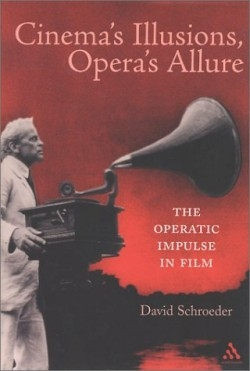It looks like you've stumbled upon a page meant to be read by our code instead of viewed directly. You're probably looking for this page.
Cinema's Illusions, Opera's Allure
The Operatic Impulse in Film
Whether or not one verbalizes a like or dislike of opera, everyone, according to the author, has been “raised culturally on something very close to opera”—the movies. Elements of opera are evident in a wide variety of films, including contemporary blockbuster films such as Star Wars and Apocalypse Now; early Griffith, Eisenstein, Chaplin, and Lang; the art films of Fellini and Bruñuel; and even Saturday morning TV cartoons featuring Mel Blanc’s famous “wabbit.” Schroeder traces the allure that opera—with its spectacle, intense emotions, lush visuals, and musical highs—has held for filmmakers since the beginnings of movie making.
The book is comprised of six parts—early cinema and opera, use of the film score, opera parody, influence of Wagner, cinema as opera, and opera films. To illustrate the effect of how a film score substantively affects the visual images, characterizations, and plot development of movies, the author describes watching the first three minutes of Citizen Kane twice, first without sound, then with sound. The addition of music connects the impressions received by both the ear and the eye so that the film changes from the isolated visual images of the editing cuts to a unified whole. Filmmakers soon appropriated the operatic concept of leitmotifs (musical themes representing a person, object, emotion, or event) and, in many instances, the use of specific melodies or compositions.
Schroeder, a music and film studies professor at Dalhousie University in Canada, establishes the underlying focus of the book: musical soundtracks, leitmotifs, borrowed musical quotations, and opera plots, stereotypes, and characters (reincarnated in film). He then explores a variety of films, illustrating, in detail, the operatic influences.
Although the book has a slightly academic feel to it (individual chapters, for example, are tightly focused, very loosely connected to preceding and/or following chapters, have good footnote documentation, and could easily stand alone as critical journal articles), the author clearly knows and enjoys both movies and opera. Schroeder provides detailed, interesting, and often wry explications of opera influences in film, which should be entertaining to both the serious and not-so-serious film student.
Reviewed by
David Reid
Disclosure: This article is not an endorsement, but a review. The publisher of this book provided free copies of the book to have their book reviewed by a professional reviewer. No fee was paid by the publisher for this review. Foreword Reviews only recommends books that we love. Foreword Magazine, Inc. is disclosing this in accordance with the Federal Trade Commission’s 16 CFR, Part 255.
